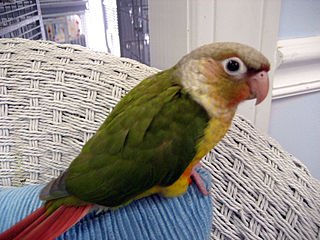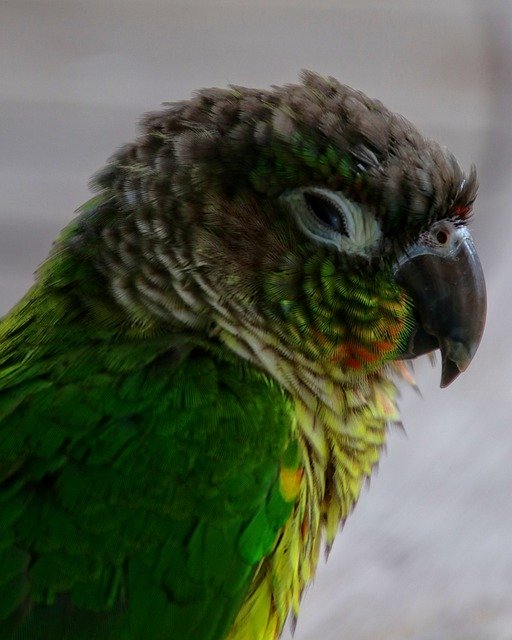Cherry-Headed Conures also known as Red-Masked Conures or Red-Headed Parakeets. They are informally named as Christmas Conures courtesy their red Santa-toned head color. Native to South America, they got world-renowned soon after the movie “The Wild Parrots of Telegraph Hills”.
Dwelling in the deciduous forests of Ecuador and Peru, they can often be seen in suburban areas or semiarid regions. Their incessant breeding in the wild has led to the establishment of their feral populations in various parts of the world including the United States and Europe.
Cherry-Headed Conure Personality
Cherry-Headed conures are medium-sized parakeets. They are highly active and social and love to interact. That said, they may take some time to get comfortable with their new companion initially. But once they are comfortable, there is no way back. One must maintain a friendly environment at home as these parrots can get easily scared.
Cherry-Headed Conure Lifespan
Cherry-Headed Conures enjoy their life in their native habitat for 10 to 12 years. But when taken to captivity, the lifespan of this bird increases incredibly. Most of the Cherry-Headed live for around 25 years. The average lifespan of a Cherry-Headed Conure can range from 25 to 35 years indoors.
In some rare cases, these birds have managed to live up to 50 years or more. This is not seen in general. But the reports have documented 50 years old Cherry-Headed Conures living happily in captivity; playing, cuddling, and enjoying. A healthy diet and extreme care have helped achieve this milestone age.
Cherry-Headed Conures are scared to death. Frightening this conure may stress him enough to harm and kill himself. Their human flock needs to talk and move slowly until the bird gets comfortable with their presence. Thus, keeping them stress-free is a key to their longevity.
Cherry-Headed Conure Colors
These conures are called cherry-headed for the specific color of their head. But most of the body of this conure is green. They sport a darker shade of green plumage. This green turns lighter as it reaches the tail. Cherry-Headed Conures have a unique splash of cherry color on their head and faces. This color flash can also be seen on the top of their wings and shoulders. The underparts of their wings are yellow. The gray beak and white rings around the eyes make them similar to other conures. But unlike other conures, they don’t have pink legs and feet. The color of Cherry-Headed Conure’s feet is gray.
In some individual Cherry-Headed Conures, the red splash of the face and head can extend down to their neck. These two colors, bright green, and cherry red certainly make a Cherry-Headed Conure a pretty parrot pet. Their color taxonomy makes them premium as pets.
Cherry-Headed Conure Breeding
Cherry-Headed Conures breed in the hotter months of the year. They mature between the ages of 1 to 3 years. The hen cherry-headed lays 3 or 4 eggs. These eggs take 24 days in incubation. The baby conures in the next 6 weeks and can be fully weaned within 12 weeks. They come out with green plumage and develop the varied coloration by the time.
For breeding a cherry-headed pair, a nest box must be made available to the pair. An ideal breeding box must be at least 16 inches in length/depth and can have its height up to 24 inches. The internal diameter must be around 12 inches and the internal dimension should be approx 10 inches.
The entry hole diameter must be 3 inches and the inspection hole can be of 4 inches in a round or square shape. A removable lid can be placed on the inspection access point as the pair will need privacy during mating. Place this nest box vertical at the angle of 45 degrees. If the pair don’t like their nest box, try another with different dimensions.
Cherry-Headed Conure Talking Ability
Cherry-Headed Conures are one of the most talkative birds. Very social and playful, they love to interact with people and cagemates alike. In the wild, they live in flocks which makes them social and interactive, and noisy sometimes.
Conures are high in pitch and so are Cherry-Headed conures. While in captivity too, they are chirpy and quick to learn while they listen. They can be easily trained for saying new words and phrases. However, cherry-headed can learn a limited vocabulary. But a non-talkative cherry-headed can also be a chatterbox with instinctive vocalizations.
Are Cherry-Headed Conures Noisy?
Cherry-Headed Conures tend to be extremely noisy. These parrots are not suitable pets for the people who live in apartments. Or for the people whose neighbors like silence. These birds are prone to screamings and screeches. At the time of sunrise and sunshine, they make pretty loud contact calls. So, if a person is bothered with noises, adopting a cherry-headed conure must be avoided at all costs.
Cherry-Headed Conure Gender Difference
No one can tell if a Cherry-Headed Conure is a male or female, simply by looking at the bird. Both male and female conures look identical. Many experts claim various ways of visual sexing like:
Size- The male cherry-headed conure size ranges from 11 to 13 inches whereas their female counterparts are visibly smaller by roughly 2 inches.
Weight- The male cherry-headed conure weight can be anywhere between 170-190 grams but the females tend to be lighter than this.
Color of the plumage- The male cherry-headed conure plumage is more bright and lively against the duller female plumage.
But all these and any such visual sexing method is not considered successfully accurate in this species’ gender determination. The only way to determine the gender of this bird is DNA sexing. DNA sexing of a Cherry-Headed Conure can be done either by a blood sample or a feather sample as instructed by the vet.
Cherry-Headed Conure Diet
In the wild, these conures are dependent on a natural feed full of fruits, seeds, tree blossoms, and insects. But this diet can differ while they are in captivity. As a pet, they are offered commercial pellet mixes, fresh vegetables, fresh fruits, and varied seed mixes. The best choice to serve a cherry-headed conure is a commercial pellet mix that is specifically designed to serve conures. A good combination of oats, millets, and sunflower seeds can be a treat to them.
Supplementing this diet with fresh fruits and vegetables makes their diet wholesome. Offer them cabbage, pears, papaya, mango, berries, plum, grapes, apples, oranges, and carrots. Dark leafy greens such as collard, kale, chicory, romaine, and turnip greens are one of the best sources of nutrients for Cherry-Headed conures.
The fruit and vegetables can be served ⅛ to ¼ cup in the morning and the evening. Removing the uneaten food is important as it might have turned bad or poisonous. Water is essential for digestion. Hence, supplying them freshwater is imperative. Keep this supply clean and regular by adding new water feeders to his cage.
Cherry-Headed Conure Health problems
Obesity
The health concerns of Cherry-Headed Conures starts with seeds. They are attracted to fatty seeds. And once fixated on such seeds, a Cherry-Headed can deny eating other foods altogether. Too much fattening seeds like safflower or sunflower can lead them to obesity which further leads to serious diseases. So, seeds must be given in a limited quantity. If one feels his bird getting obsessed over a seed diet, it must be controlled almost immediately. Start offering more pellets and fruit supplements to the bird.
Depression
Cherry-Headed Conures should never be neglected. This may cause aggression and stress to the bird. The pent-up frustration pushes the bird into depression and can lead to the bird harming himself.
Respiratory Concerns
Cherry-headed conures are prone to respiratory concerns arising due to fungal infections. In most cases, peanuts are the reason for fungus in cherry-headed. Experts advise not to serve them peanuts. The infection must be treated immediately with antifungal medications.
Bacterial Infections
Like fungi, bacteria can cause respiratory problems to these birds. The best way to avoid this is to keep the cage and surroundings of the bird clean. Wash the food and water bowls regularly and discard the uneaten/stale food to avoid bacterial growth. This infection can also be cured with antibiotics drugs.
Bleeding Syndrome
Sometimes, these birds may face unexpected and unusual bleeding. Common health concern in the cherry-headed conures, origin of it is still not known. It can, however, be avoided by administering all the essential vitamins to the bird. Clotting medications are recommended in case of cuts.
Summing Up
Cherry-Headed Conures stand out courtesy their lovely bright green plumage along with the cherry patch on the head. These parrots live in flocks in the wild and are very social. And their outgoing nature makes it easier for the owner to form a quick but deep bond with them. Offer them adequate care and a balanced diet to have their companionship for the next 25 or 30 years of life. Who knows, they can still be there in their 50s.
Feautured Photo Credit: Jef Poskanzer / CC BY (https://creativecommons.org/licenses/by/2.0)





